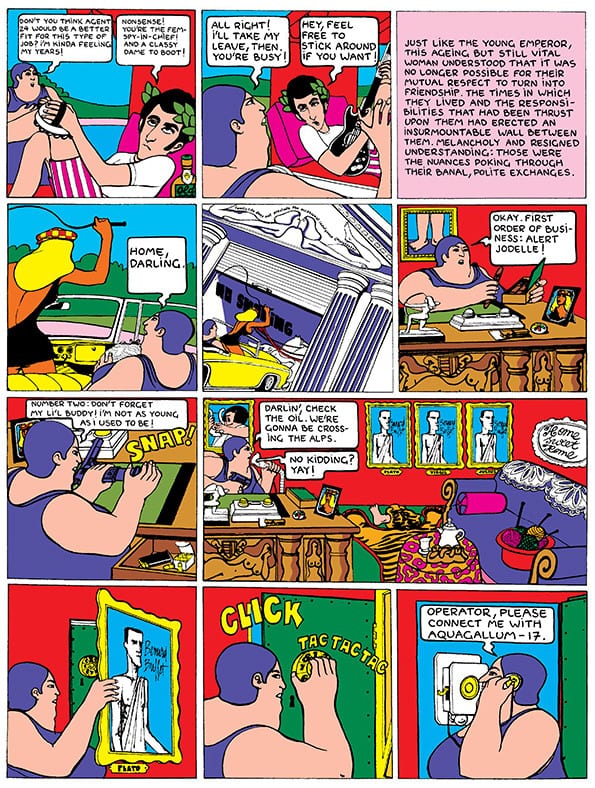In 1965, Belgian designer, art director and artist Guy Peellaert created The Adventures of Jodelle, published in France and later the U.S. by Grove Press. The new book The Adventures of Jodelle, published by Fantagraphics, contains the original remastered and translated Jodelle comic and an 80-page supplement on the life and work of Peellaert, Guy Peellaert, Fragments of the Pop Years. This review speaks mainly to the comic.
The world of Jodelle confuses the realms of advertisement and fiction. Fetishization of both contemporaneous industrial design and the female figure are at the forefront of every panel, and singular images are duplicated throughout the pages. Jodelle speaks into a Swedish L.M. Ericsson phone, lovingly rendered in her long fingers. Her dress slides off as she lounges in front of an Eames Eiffel chair. Caesar pops an Alka-Seltzer. Thought bubbles illustrating sexual fantasies take the format of highway billboards. What disrupts the banal world of advertising is that the copy has been switched with detached dialogue and confusing voiceovers.
The result is a story gleefully unconcerned with making sense, despite adhering, sort of, to a three-act structure. In the year 14, Rome is home to orgies, muscle cars, vampires, the undead, and spies. Jodelle, a special agent with a ginger bob and ever-fluctuating costume, is on a mission to recover government secrets. The mission leads her through sleazy motels, amusement parks, and dungeons, and into a world of fluid sexuality and violence. The characters and environments have been flattened, elongated, and articulated in Technicolor throbs. Interiors resemble drawn versions of Richard Hamilton’s collages. Jodelle dons sweater dresses, tracksuits, over-the-knee socks, togas, swimsuits, Paco Rabanne-esque dresses, and frequently, nothing at all. Her ability to shift appearances functions like Oedipa Maas’s ability to do the same in Thomas Pynchon’s Crying of Lot 49; by assuming different feminine archetypal identities, she gains access to different levels of information in a turbulent, absurd world.

As such, throughout the story, Jodelle is consistently desired and consumed as if a product, sometimes acting on her own desires, rebuking others’ desires via slapstick violence. As in Jean-Claude Forest’s Barbarella stories, sexual encounters can function as currency, both to gain intelligence and to move the story along. What’s interesting about Jodelle is that she seems to have more agency and bite than Barbarella, and functions as an actualized character rather than as a platform for projected sexual desire, despite operating in a world where desire and consumption run the show.
The Rome Jodelle and her friends and enemies occupy is a city that operates in the tension between inoculated indulgence and social unrest. The comic is critical of both sides of the coin—the slaves to the empire, the perverse do-littles, and the dropouts function free from individual thought and are highly suggestible. Their character designs are almost exact reproductions of each other save for differently colored hair and/or clothes, even down to the poses. This stylistic choice mirrors the use of repetition in pop art and recalls mass production- despite the world of advertising’s promise to define consumers as individuals, our consumption blends us into the masses. Peellaert seems to suggest that willfully operating as part of any system does the same.
The Adventures of Jodelle comic runs less than half of the book. The rest is dedicated to essays and reproductions of Peellaert’s work as an artist, art director, and cartoonist. This half of the book provides necessary context for the preceding comic, and is the most definitive collection of scholarship on Peellaert that I’ve seen produced in English, including images from his work on makeup kits with chanteuse and Gainsbourg muse France Gall and from his brush with Jean-Luc Godard (who was interested in adapting his Pravda comic into a film).

I absolutely adore this book. The comic is anomalous, weird, sexy, and perversely beautiful. I selfishly wish the book could have included a translation of Pravda in addition to Jodelle, but I’m grateful Peellaert’s work has finally received the treatment it deserves in English. It’s a fascinating aesthetic and narrative achievement and much more than a novelty artifact from a period of aesthetic overhaul.
Stray thoughts:
-An essay by Pierre Sterckx in the supplement points to the influence of Roy Lichtenstein on Peellaert’s comics and design work, which creates an interesting translation of U.S. comics visually consumed via U.S. pop art and filtered into European comics.
-The re-lettering by Rich Tommaso is very nice.
-It’s interesting to see yé-yé girls folded into the pages: Jodelle was modeled after French singer Sylvie Vartan, and Pravda resembles Francoise Hardy.







